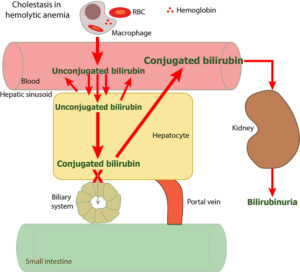In a hemolytic anemia, increased amounts of unconjugated bilirubin are produced from excessive premature removal of RBCs, typically by extravascular hemolysis (intravascular hemolysis contributes a little to bilirubin production – the small proportion of free hemoglobin that is bound to haptoglobin is taken up by macrophages as a hemoglobin-haptoglobin complex, and the hemoglobin is degraded to unconjugated bilirubin; any unbound or free hemoglobin is excreted in the urine). The unconjugated bilirubin binds to albumin and is taken up by hepatocytes.
If (and only if) liver uptake cannot keep with production, unconjugated or indirect bilirubin concentrations will increase in blood.
If cholestasis develops concurrently (e.g. downregulation of bilirubin transporters due to hypoxia or inflammatory cytokines), conjugated bilirubin is no longer excreted and is refluxed back into blood as well (via reversal of the transporters). The conjugated bilirubin in blood is freely filtered by the glomerulus into the urine, because it is water soluble. Cholestasis can be recognized by a bilirubinuria that is excessive for a urine specific gravity (USG) in a dog or a bilirubinuria regardless of the USG in any other species. Conjugated or direct bilirubin concentrations will also increase in blood with cholestasis, but bilirubinuria will precede a direct bilirubinemia in cholestasis. Direct and total bilirubin concentrations can be quite high in affected animals not only due to the cholestasis but because more conjugated bilirubin is being produced from the excess unconjugated bilirubin that is taken up by the hepatocytes from blood due to the hemolytic process (think about a funnel, with the large opening being production of unconjugated bilirubin by the hemolytic process and the narrow opening being excretion of conjugated bilirubin, which is the rate-limiting step of bilirubin metabolism).
This cholestatic component to hyperbilirubinemia in a hemolytic anemia is most frequently seen in dogs with immune-mediated hemolytic anemia and foals with neonatal isoerythrolysis. It is not known why some animals with these two types of hemolytic anemia develop cholestasis, but direct or conjugated bilirubin can dominate the bilirubin split in these animals.

